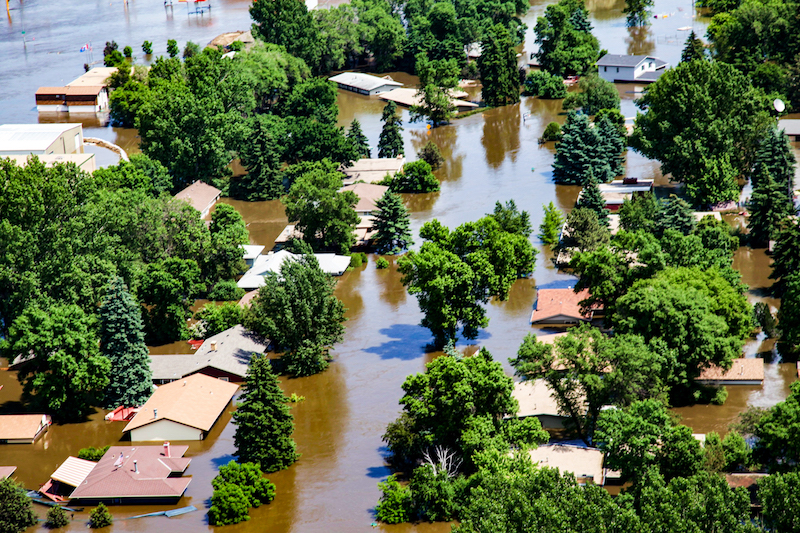Last June, Minot, N.D., received $74.3 million it was awarded in January 2016 as one of the winners of HUD’s resilience competition. The city, which was hit hard by flooding in 2011, will use that money over the next five years to reduce flood risks and improve water quality, build resilient and affordable neighborhoods, and diversify its economy.
This is part of a much larger flood-control effort that could cost up to $700 million, and involves FEMA, the Army Corps of Engineers, the state of North Dakota, and Minot, which will kick in $337 million over the next decade, says John Zakian, a former consultant with New York City’s resilience program, who now manages Minot’s National Disaster Resilience Program.
About half of the HUD money, $20 million, is financing the buyout of 170 single-family homes, and 190 total properties, along the river, tearing them down and turning that area into wetlands and flood barriers. Another $12 million was set aside for building multifamily housing, and to acquire property for a homeless shelter and downtown park, outside of the new flood plain.
Zakian says the city mandated the sale of the homes, but only had to invoke eminent domain on three houses.
Minot’s actions are further evidence that climate-induced migration—a/k/a relocation of populations at risk—is no longer off the table for municipalities as part of their disaster resilience strategies. And with FEMA’s National Flood Insurance Program already $25 billion in debt to the U.S. Treasury, rebuilding in vulnerable areas gets more financially precarious by the day.
“Eventually, people are going to have to face up to this reality,” says Rachel Minneri, who oversees AIA’s disaster assistance, resilience, adaptation, and sustainable community development programs. She points out that while FEMA doesn’t publish information about relocations, they’re actually a lot more common than is generally perceived.
Some examples of places where relocations are more than idle chatter:
- After being flooded in 2013, Boulder County in Colorado initiated a “Building Back Better” program that included buying back flood-damaged properties that would pose a future high risk, and turning those properties into undeveloped land in perpetuity. The county paid $26.8 million to acquire 46 properties, and was wrapping up demolition in September 2017;
- Hundreds of residents in Ottawa, Ont., abandoned their homes to escape record flooding in April. The city has told homeowners they could apply for government assistance to rebuild or repair one more time, and that’s it;
- Oregon school districts have been pulling schools out of tsunami zones, says Erica Fischer, PhD, PE, an assistant professor at Oregon State University who, until last August, was a design engineer with Degenkolb Engineers;
- Louisiana’s new master plan calls for paying 20,000 coastal residents to relocate. The state is currently engaged in a $48 million pilot program that includes relocating residents of 29 homes on Isle de Jean Charles, a narrow island that’s sinking into the Gulf of Mexico.
It’s worth noting, too, that only 17% of Houston-area homeowners have flood insurance, and federal disaster relief is capped at $33,000, hardly enough on its own to rebuild a destroyed house.
But convincing people to relocate is a psychological hurdle: just look at how many ignore evacuation orders, or keep returning, year after year, to regions afflicted by floods, tornados, and fires. Mandated relocation also devalues the forsaken property. And what still isn’t clear, says Josh Sawislak, AECOM’s Global Director of Resilience, is the value of such property beyond its existing primary function.
But if the government and insurers start cutting off, or even significantly reducing, dollars to rebuild and restore, resilience is going to mean relocation for a lot more at-risk Americans. “Those discussions are going to happen,” says Illya Azaroff of +LAB Architects and Experimentation in Brooklyn, N.Y., which has started downzoning coastal neighborhoods like Red Hook, and upzoning places outside of the borough’s flood plain.
Related Stories
Resiliency | Jan 2, 2024
Americans are migrating from areas of high flood risk
Americans are abandoning areas of high flood risk in significant numbers, according to research by the First Street Foundation. Climate Abandonment Areas account for more than 818,000 Census Blocks and lost a total of 3.2 million-plus residents due to flooding from 2000 to 2020, the study found.
Sustainability | Jan 2, 2024
Los Angeles has plan to improve stormwater capture and source 80% of water locally
Los Angeles County’s Board of Supervisors voted for a plan to improve stormwater capture with a goal of capturing it for local reuse. The plan aims to increase the local water supply by 580,000 acre-feet per year by 2045.
75 Top Building Products | Dec 13, 2023
75 top building products for 2023
From a bladeless rooftop wind energy system, to a troffer light fixture with built-in continuous visible light disinfection, innovation is plentiful in Building Design+Construction's annual 75 Top Products report.
Codes and Standards | Nov 27, 2023
Hoboken, N.J.’s street design policies are saving lives
Transportation policies enacted in Hoboken, N.J. over the past several years are paying off in the form of fewer pedestrian deaths and injuries. The city has adopted daylighting, bike lanes, lower speed limits, and intersection redesigns to make its roads safer.
Resiliency | Nov 27, 2023
All levels of government need to act to cope with climate-driven flooding and sea level rise
The latest National Climate Assessment highlights the need for local, state, and federal governments to adopt policies to mitigate the effects of climate-driven flooding and sea level rise, according to a policy expert with the National Resources Defense Council.
Resiliency | Nov 16, 2023
How inclusive design supports resilience and climate preparedness
Gail Napell, AIA, LEED AP BD+C, shares five tips and examples of inclusive design across a variety of building sectors.
Codes and Standards | Nov 10, 2023
Washington state building codes to protect structures from wildfire provoke controversy
New building codes in Washington state intended to protect structures from wildfires are provoking backlash from builders, cities, and environmentalists. Critics charge that the rules that are scheduled to take effect March 15 are confusing, will increase housing costs, and could cause too many trees to be cut down.
Sustainability | Nov 1, 2023
Researchers create building air leakage detection system using a camera in real time
Researchers at the U.S. Department of Energy’s Oak Ridge National Laboratory have developed a system that uses a camera to detect air leakage from buildings in real time.
Resiliency | Oct 19, 2023
Jacksonville unveils 50-year strategy for resiliency to flooding, extreme heat, wildfires
The City of Jacksonville, Fla., recently released plans for Resilient Jacksonville, a 50-year resiliency strategy to reduce the risks from flooding, hurricanes, excessive heat, and wildfires, and to respond better to those events. The plan includes ways to stop the St. Johns River from flooding vulnerable neighborhoods, including those prone to flooding during heavy rain or hurricanes.
Engineers | Oct 12, 2023
Building science: Considering steel sheet piles for semi-permanent or permanent subsurface water control for below-grade building spaces
For projects that do not include moisture-sensitive below-grade spaces, project teams sometimes rely on sheet piles alone for reduction of subsurface water. Experts from Simpson Gumpertz & Heger explore this sheet pile “water management wall” approach.

















